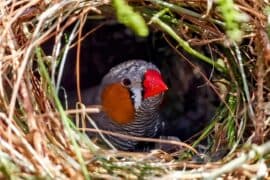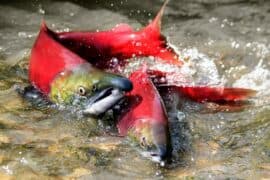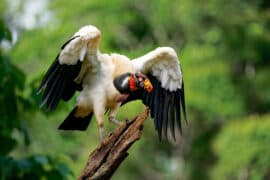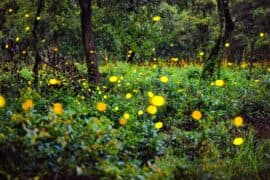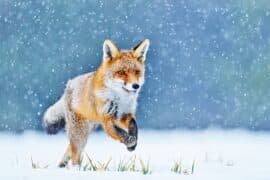Western bluebird
(Sialia mexicana)
Description
Sialia mexicana, commonly known as the western bluebird, is a small and brightly colored bird found in North America. This species is a member of the thrush family (Turdidae), which includes other iconic birds such as the American robin and the Eastern bluebird. In this article, we will explore the characteristics, behavior, and habitat of Sialia mexicana, and learn why it is such a beloved bird among bird enthusiasts. Physical Characteristics Sialia mexicana, also known as the western bluebird, is a small and brightly colored bird found in North America. It measures about 6.5 inches (16.5 cm) in length and weighs between 0.8 and 1 oz (23-28 g). Male western bluebirds are slightly larger than females, with longer wings and tails. The western bluebird is easily recognizable due to its striking blue plumage on the head, wings, and back, which contrasts with the rusty-orange breast and sides. The belly is white, and the eyes are dark. The bill is short and straight, and the legs are relatively long and thin. Juvenile western bluebirds are less colorful than adults, with a duller blue coloration and a streaked breast. However, they still have the characteristic blue patches on the wings and tail that distinguish them from other young thrushes. Habitat and Range Sialia mexicana, or the western bluebird, is found throughout western North America, from southern Alaska to central Mexico. Its range extends from the Pacific Coast to the eastern Rocky Mountains. Western bluebirds are found in a wide range of habitats, from sea level to high elevations (up to 10,000 feet or 3,000 meters). They prefer open woodlands, savannas, and grasslands with scattered trees and shrubs, where they can find natural or artificial cavities for nesting. They are often associated with oak woodlands and Ponderosa pine forests in the western United States. Western bluebirds can also be found in suburban and agricultural areas with suitable habitat, such as orchards, vineyards, and golf courses. In the winter, western bluebirds move to lower elevations and are often found in more open habitats, such as desert scrub, chaparral, and agricultural fields. They may form small flocks outside of the breeding season and can often be seen perching on fences, utility wires, and other elevated objects. Behavior Sialia mexicana is a relatively social bird that forms monogamous pairs during the breeding season. Males defend a territory that includes a nesting site, where they perform courtship displays and sing to attract females. Once a pair has formed, they build a nest together, usually in a natural cavity or a birdhouse. The nest is made of grass, twigs, and other plant material and is lined with feathers and other soft materials. Western bluebirds are primarily insectivorous, feeding on a wide variety of insects such as grasshoppers, beetles, and caterpillars. They also eat spiders and other small arthropods. During the winter, they may switch to a more fruit-based diet, consuming berries and seeds from shrubs and trees. The western bluebird is a migratory bird that moves from higher elevations to lower elevations in the winter. In the summer, they are generally found in open woodlands, savannas, and grasslands, where they can find natural or artificial cavities for nesting. Western bluebirds are relatively social and often form small flocks outside of breeding season. They are not aggressive birds and are generally peaceful towards other birds, although males may occasionally engage in territorial disputes. Diet Sialia mexicana, or the western bluebird, is primarily insectivorous, feeding on a wide variety of insects such as grasshoppers, beetles, and caterpillars. They also eat spiders and other small arthropods. During the winter, they may switch to a more fruit-based diet, consuming berries and seeds from shrubs and trees. Their insectivorous diet is particularly important during the breeding season when they need a lot of protein to feed their young. Western bluebirds are known to forage on the ground, in shrubs, and on the lower branches of trees, searching for insects and other small prey. They may also catch insects in flight or pluck them from vegetation. Western bluebirds have been known to take advantage of human-provided food sources such as mealworms or suet cakes, particularly during harsh winter conditions when insects and other natural food sources may be scarce. However, it is generally recommended to avoid providing human food to wild birds as it can disrupt their natural diet and may lead to dependence on these sources. Conservation Status The western bluebird, is not considered globally threatened or endangered by the International Union for Conservation of Nature (IUCN). However, populations of western bluebirds have declined in some areas due to habitat loss, competition with introduced species, and changes in land use. In response to these threats, many conservation organizations and individuals have taken action to protect this species. One major conservation effort involves the installation of nest boxes, which provide additional nesting sites for western bluebirds in areas where natural cavities are limited. These nest boxes can be made from wood, PVC pipe, or other materials and can be designed to mimic natural cavities. Other conservation actions include planting native vegetation, restoring degraded habitats, conducting research to better understand the ecology and behavior of western bluebirds, and promoting awareness and education about this species. In some areas, western bluebirds are also protected by state and federal laws, which prohibit the capture, harassment, or killing of these birds. Overall, the western bluebird remains an important symbol of the natural beauty and diversity of the North American landscape, and efforts to protect and conserve this species are ongoing. Conclusion Sialia mexicana, the western bluebird, is a beautiful and beloved bird of western North America. Its bright blue plumage, cheerful song, and social behavior make it a popular sight for bird enthusiasts and casual observers alike. While it faces some threats to its populations, efforts to protect and conserve this species are ongoing, and it remains an important symbol of the natural beauty and diversity of the North American landscape.
Taxonomic tree:


